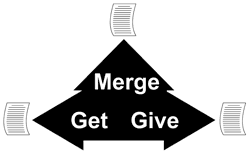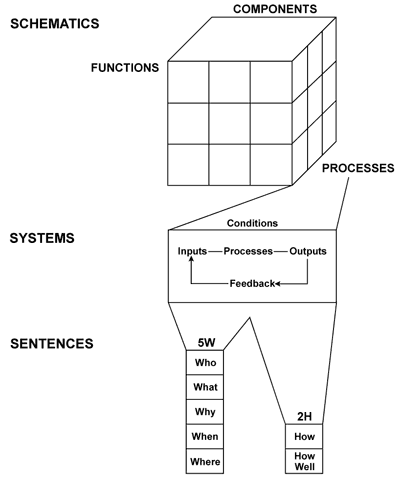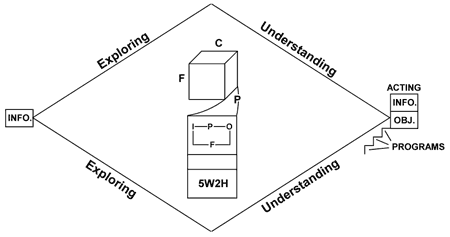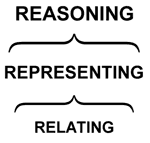Thinking Wars America:
5. Every Child Gets Ahead
“No Child Left Behind” is legislation that leaves every child behind. It simply does not prepare the 21st century learners for the world they must address. This is a world that requires Generative Thinking Skills. This is legislation that delivers only conditional responding skills.
Generative Thinking Architecture
The mission of Generative Thinking is to create responses where there were none. Indeed, the precise definition of Generative Thinking is as follows:
To create responses that the stimuli were not intended to elicit.
In other words, thinking generates new and more productive responses to the continuously-changing stimulus conditions of our time.
There are three sets of processing systems involved in Generative Thinking:
- Relating to elicit images;
- Representing to develop new images;
- Reasoning to generate or create the most productive images.
These processing systems are transformed into thinking skills in systematic training programs.
Relating Skills
The first set of processing skills emphasizes “Relating to Elicit Images.” This means that we employ our “Information Communication Skills” to obtain images of any phenomena or circumstances (See Figure 4):
- Responding accurately to get others’ images;
- Initiating operationally to give our images;
- Negotiating merged images of phenomena.
Relating is the essential beginning phase in Generative Thinking because it yields images of conceptual information with which to reason.

Figure 4. Relating to Elicit Images
Representing Skills
The second set of processing skills emphasizes “Representing to Develop New Images.” This means that we employ our “Information Representing Skills” to develop new images of any phenomena or circumstances (See Figure 5):
- Sentences or conceptual levels of information;
- Systems or operational levels of information;
- Schematics or dimensional levels of information.
Relating is the necessary transitional phase in processing because it yields us images of operational information with which to reason.

Figure 5. Representing to Develop New Images
Reasoning Skills
The third and culminating set of processing skills emphasize “Reasoning to Generate the Most Productive Images.” This means that we employ “Information Reasoning Skills” to generate newer and more productive images of any phenomena or circumstance (See Figure 6):
- Exploring by expanding images of information;
- Understanding by narrowing images of information;
- Acting by defining information objectives.
Reasoning is the culminating phase in Generative Thinking because it yields us new and more productive information objectives for acting.

Figure 6. Reasoning to Generate More Productive Images
To sum, the three phases of Generative Thinking are “nested” or “housed” in generative thinking:

Figure 7. The Phases of Generative Thinking
Relating elicits the images that Representing develops and Reasoning processes generatively. Systematically trained and implemented, Generative Thinking creates totally new images of information with which we can create our own changeable destinies.
In summary, perhaps the most grievous harm of “No Child Left Behind” is this: because we actually “swallowed the bait—hook, line and sinker,” we got “stuck” with the “switch, hook line and stinker”—the empty promises that we made and “kept” to our children.
We placed the students in “double jeopardy.” Those who were initially “held back” by adults, were now systematically “held back” by their teachers, all in the name of “leaving no child behind.”
In transition, the best thing that can be said about “No Child Left Behind” is that children are learning the wrong things. The worst thing that could be said is that they are getting “dumber” as they achieve higher standards.
Our conclusion may be best represented by the question asked by the “Prime Mover” of this legislation:
“Is the children learning?”

October 15th, 2007 at 3:22 pm
Dear Bob,
What you’ve presented here is the case for the new 3Rs of education. We need to teach our children to relate by creating new responses to changing conditions and by elevating images in collaboration with others. We need to teach our children to represent the information with which they are continually bombarded through multi-dimensional schematics. And we need to teach our children to reason with their newly represented information and to act after they have processed, not before. What the No Child Left Behind promulgators did was to simplify before processing because they were afraid of the complexities given their incompetence and resisted the complexities given their lack of curiosity. We can only simply after we have worked our way through the complexity. And our solutions will only be as good as our processing capabilities and our willingness to explore multiple sources and understand all the variables. You have generated a system that will help us create sustainable solutions.
October 16th, 2007 at 1:12 pm
Dear Bob,
I think this was a very well articulated analysis of some of the issues facing our educational system. I think one of the main themes that I’ve drawn out of this is not only is No Child Left Behind failing to teach our children knowledge, it’s failing to teach our children how to think. Children are not given a framework for understanding their forced memorization, nor are they learning to identify critical components of materials in order to ask questions and apply what they’ve learned.
As you said they are not learning to generative thinking. In today’s world with so much change what knowledge you possess is not nearly as important as having the ability to think critically. Because the “most important knowledge” of the time is changing so quickly it’s more important to know how to learn and to think. Your 3Rs model is an answer to this challenge.
October 20th, 2007 at 5:47 pm
Dear Bob,
As you and Rick and George have stated, the new 3Rs will help children meet their thinking requirements. The 3Rs will help children interact with their world and in their world with all the promises that freedom and thinking provide.
But how will children learn these 3 Rs from a world where maturity of modeling and teaching are often missing? How will children know what relating, representing, and reasoning are when their teachers, their parents, their leaders are too busy, too afraid, too distracted? Will the children get ahead of the so called adults. Perhaps if we are lucky, the children will create an answer we are no longer offering as a choice.
So, the bumper sticker phrase is not a prescription for the children as it has been operationalized but perhaps a representation of a concept to wake up the sleeping adults in the world before the children are left to find their own way. There is no child who should be left behind or left as an orphan if mature adults were relating, representing, reasoning with each other and for each other and for others.
I think one of the first steps in helping to insure that no child is left behind is that all adults must be awakened to thinking about freedom. Your freedomblog is a great first place for informing this thinking. Thanks for doing your part by establishing a freedomblog, defining the ingredients and models for thinking, continuing to lead the building of reason and perspective, and for acting with full intention. Thank you for your continued commitment to challenging our thinking.
November 12th, 2007 at 3:26 pm
Dear Bob,
I dream of freedom, of peace, of kindness, of relationships, of ideas, of humanity, of …………..
As a teacher, a woman, a mother, a daughter, these are thoughts that have never lost their meaning in my mind, my body, my words, and hopefully my actions. However, after reading your freedomblog.com postings, it is very clear that these are not words alone. Each of these concepts rests on some basic assumptions – embedded principles:
• Freedom requires responsibility, action, and thinking
• Peace is a decision to relate and to act with full reasoning
• Relationships require listening, understanding, action, and feedback
• Ideas are the source of growth and possibilities
• Full humanity requires learning
But you have also shown how these words are not only concepts and principles. There are additional standards and skills that can be learned and modeled.
• To live free and to help others live free requires skills, systems, and models. To live free requires a commitment to others.
• To create peace requires the skills for relating to others, to the world and the skills for generating of new forms of wealth: information, human, financial.
• To relate to others and to the world requires listening and helping skills
• To reason is to know how to understand the current conditions and to be willing and able to generate goals and systems to move forward. To reason is to be willing to act.
• To create ideas requires the skills to see and hear the needs and requirements of today as the base for creating and representing new ideas.
• To enjoy humanity requires the power and the skills to fall in love with a new idea, a new person: to have skills to learn from the world.
And so, the ability to relate, to represent, to reason are skills (the necessary conditions) that will help the children of the world take a step to being free and to enjoying the benefits of kindness, of peace, of a full humanity (the new standards). The new 3Rs will help ideas such as freedom and peace be possible. The new 3Rs will help operationally insure that we meet changing standards. The new 3Rs will help generate the highest common denominator for the next moment. Without the tools to relate, to represent, and to reason, the beauty of abstract thoughts such as freedom is lost in a dream. These are the skills that can help fulfill the promises inherent in such words as freedom, peace, and ideas.
Perhaps it is time to want freedom, peace, kindness, relationships enough to pay the price to learn how to relate fully, respond accurately, and reason to create new initiatives that make words such as these live for all the children. Perhaps we can create an educational model that helps children and the world build dreams such as these. There is little doubt that if we really want these dreams to come true, we must pay the price to learn the skills that make the standards of freedom, of peace, of ideas possible.
And so, can we ask the American people to vote for freedom, for peace, for creation of ideas for all children? Is there a Presidential team that understands that these abstract concepts are all possible if we make a commitment to building skills in relating, representing, and reasoning for freedom, for peace, for dreaming, and for growth? Is there a moment in this very complex world where dreams can become more than dreams?